The Tree Panel Component is one of the most versatile Components in Ext JS and is an excellent tool for displaying heirarchical data in an application. Tree Panel extends from the same class as Grid Panel, so all of the benefits of Grid Panels - features, extensions, and plugins can also be used on Tree Panels. Things like columns, column resizing, dragging and dropping, renderers, sorting and filtering can be expected to work similarly for both components.
树面板组件是在 ExtJS 里面最多彩缤纷的组件之一,用于显示层次状明显的数据来说十分适合。树面板跟 Grid 都是来自同一个基类的,之所以这样的设计,是为了那些扩展或者插件统统都可以复用一致的功能。比如多列、尺寸控制、拖放、渲染和筛选这些功能都是两者共性的内容。
Let's start by creating a very simple Tree.
让我们开始创建一个颗非常简单的树。
Ext.create('Ext.tree.Panel', {
renderTo: Ext.getBody(),
title: 'Simple Tree',
150,
height: 150,
root: {
text: 'Root',
expanded: true,
children: [
{
text: 'Child 1',
leaf: true
},
{
text: 'Child 2',
leaf: true
},
{
text: 'Child 3',
expanded: true,
children: [
{
text: 'Grandchild',
leaf: true
}
]
}
]
}
});
This Tree Panel renders itself to the document body. We defined a root node that is expanded by default. The root node has three children, the first two of which are leaf nodes which means they cannot have any children. The third node is not a leaf node and has has one child leaf node. The text property is used as the node's text label. See Simple Tree for a live demo.
此树面板渲染到 document.body 元素上。我们把定义的根节点(The Root Node)自动扩张开来,这是默认的情况。根节点有三个子节点 ,其中前两个是 leaf 节点,表示他们下面没有任何子节点(children)了(终结了)。第三个节点是一个叶子节点,已经有一个 child 的叶节点(one child leaf node)。 text 属性是节点的显示的文本。可打开例子看看效果如何。
Internally a Tree Panel stores its data in a TreeStore. The above example uses the root config as a shortcut for configuring a store. If we were to configure the store separately, the code would look something like this:
树面板的数据存储在 TreeStore。上面的例子看不见 Store 配置的地方不是没有 Store,而是使用内部缺省的。如果我们要另外配置不同的 Store,应该看起来像这样:
var store = Ext.create('Ext.data.TreeStore', { root: { text: 'Root', expanded: true, children: [ { text: 'Child 1', leaf: true }, { text: 'Child 2', leaf: true }, ... ] } }); Ext.create('Ext.tree.Panel', { title: 'Simple Tree', store: store, ... });
For more on Stores see the Data Guide.
参阅《DataGuide》以了解更多 Store 内容。
The Node Interface
In the above examples we set a couple of different properties on tree nodes. But what are nodes exactly? As mentioned before, the Tree Panel is bound to a TreeStore. A Store in Ext JS manages a collection of Model instances. Tree nodes are simply Model instances that are decorated with a NodeInterface. Decorating a Model with a NodeInterface gives the Model the fields, methods and properties that are required for it to be used in a tree. The following is a screenshot that shows the structure of a node in the developer tools.
从上面的例子我们可以看到关于树节点其下的许多属性。那么真正的节点究竟为何物?前面已提到过,树面板绑定到 TreeStore。而 ExtJS 中的 Store 是负责管理 Model 实例的集合。树节点只是 Model 实例通过 NodeInterface 的装饰接口。用 NodeInterface 装饰 Model 的好处是赋予了 Model 在树控件的状态下,有新的方法与属性。以下的截图显示了在开发工具节点其结构如何。
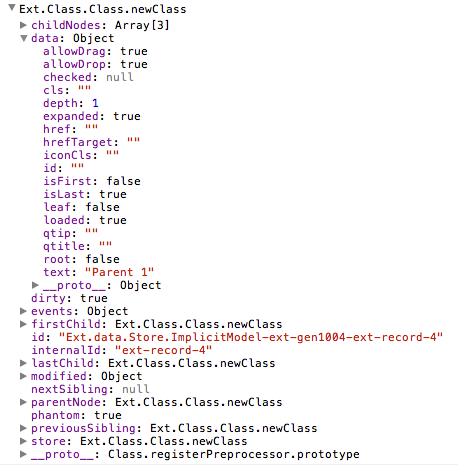
In order to see the full set of fields, methods and properties available on nodes, see the API documentation for the NodeInterface class.
要全面了解一下节点的属性、方法、事件,应参阅 API 文档。
Visually changing your tree
Let's try something simple. When you set the useArrows configuration to true, the Tree Panel hides the lines and uses arrows as expand and collapse icons.
让我们试试简单的。在你设置 useArrows 配置项为 true 的时候,树面板会隐藏旁边的线条,而采用图标箭头表示展开和折叠。

Setting the rootVisible property to false visually removes the root node. By doing this, the root node will automatically be expanded. The following image shows the same tree with rootVisible set to false and lines set to false.
设置根节点的 rootVisible 可决定根节点显示与否。通过这样做的话,一般就是根节点会自动扩大。下面的图片显示,rootVisible 设置为 false,并设置 lines 为 false 的时候看不见线的树。
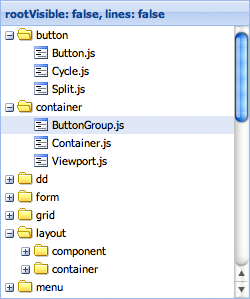
Multiple columns
Since Tree Panel extends from the same base class as Grid Panel adding more columns is very easy to do.
鉴于树面板跟 Grid 面板来自同一个基类,所以构成多列是非常轻松的。
var tree = Ext.create('Ext.tree.Panel', { renderTo: Ext.getBody(), title: 'TreeGrid', 300, height: 150, fields: ['name', 'description'], columns: [{ xtype: 'treecolumn', text: 'Name', dataIndex: 'name', 150, sortable: true }, { text: 'Description', dataIndex: 'description', flex: 1, sortable: true }], root: { name: 'Root', description: 'Root description', expanded: true, children: [{ name: 'Child 1', description: 'Description 1', leaf: true }, { name: 'Child 2', description: 'Description 2', leaf: true }] } });
The columns configuration expects an array of Ext.grid.column.Column configurations just like a Grid Panel would have. The only difference is that a Tree Panel requires at least one column with an xtype of 'treecolumn'. This type of column has tree-specific visual effects like depth, lines and expand and collapse icons. A typical Tree Panel would have only one 'treecolumn'.
和 Grid 面板那样子配置 Ext.grid.column.Column,Tree 面板也是通过 columns 数组进行配置。唯一区别在于 Tree 面板至少得要一个 xtype 是“treecolumn”的列。该类型的列根据树而设计的,拥有深度(depth)、线条(lines)、展开与闭合图标等的特性。典型的 Tree 面板便是一个单独的“treecolumn”。
The fields configuration is passed on to the Model that the internally created Store uses (See the Data Guide for more information on Models). Notice how the dataIndex configurations on the columns map to the fields we specified - name and description.
配置项 fields 会由内部的 Store 被复制到 Model 上(该方面可参阅《Data Guide》的 Model 部分)。请注意列其 dataIndex 配置项就是映射到 field 的。
It is also worth noting that when columns are not defined, the tree will automatically create one single treecolumn with a dataIndex set to 'text'. It also hides the headers on the tree. To show this header when using only a single column set the hideHeaders configuration to 'false'.
应该提出,当未定义列的时候,树会自动创建一个单独的 treecolumn,带有“text” 的 dataIndex。还会隐藏树的头部。要显示的话,可设置配置项 hideHeaders 为 false。
Adding nodes to the tree
The root node for the Tree Panel does not have to be specified in the initial configuration. We can always add it later:
不一定要在配置的时候将所有的节点添加到树上,及后再加也可以的。
var tree = Ext.create('Ext.tree.Panel'); tree.setRootNode({ text: 'Root', expanded: true, children: [{ text: 'Child 1', leaf: true }, { text: 'Child 2', leaf: true }] });
Although this is useful for very small trees with only a few static nodes, most Tree Panels will contain many more nodes. So let's take a look at how we can programmatically add new nodes to the tree.
这样子在一棵静态的树上加上几个节点毫无问题,但是一般而言树面板还是会动态地加入许多节点。这样我们就来看看如何通过编程来添加新的节点树。
var root = tree.getRootNode(); var parent = root.appendChild({ text: 'Parent 1' }); parent.appendChild({ text: 'Child 3', leaf: true }); parent.expand();
Every node that is not a leaf node has an appendChild method which accepts a Node, or a config object for a Node as its first parameter, and returns the Node that was appended. The above example also calls the expand method to expand the newly created parent.
只要不是 leaf 节点,它都有 appendChild 的方法,送入一个节点的实例,或者节点的配置项对象作为参数,该方法就是返回新创建的节点。上一例调用了新创建节点其 expand 的方法。

Also useful is the ability to define children inline when creating the new parent nodes. The following code gives us the same result.
另外你可以通过内联的写法创建父节点。下一例与上例的作用一样。
var parent = root.appendChild({ text: 'Parent 1', expanded: true, children: [{ text: 'Child 3', leaf: true }] });
Sometimes we want to insert a node into a specific location in the tree instead of appending it. Besides the appendChild method, Ext.data.NodeInterfacealso provides insertBefore and insertChild methods.
有些时候我们想将节点插入到某个固定的位置。这样的话,就需要 insertBefore 或 insertChild 方法,都由 Ext.data.NodeInterface 提供。
var child = parent.insertChild(0, { text: 'Child 2.5', leaf: true }); parent.insertBefore({ text: 'Child 2.75', leaf: true }, child.nextSibling);
The insertChild method expects an index at which the child will be inserted. The insertBefore method expects a reference node. The new node will be inserted before the reference node.
insertChild 方法需要一个 child 将被插入索引。 insertBefore 方法预计的参考节点。将参考节点之前插入新的节点。
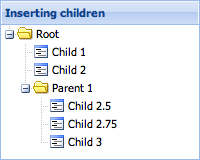
NodeInterface also provides several more properties on nodes that can be used to reference other nodes.
NodeInterface 还提供了以下几个属性,供其他节点作“引用”时之用。
Loading and Saving Tree Data using a Proxy
Loading and saving Tree data is somewhat more complex than dealing with flat data because of all the fields that are required to represent the hierarchical structure of the tree. This section will explain the intricacies of working with tree data.
加载和保存tree数据要比处理平面数据复杂,因为数据代表了树形层次结构。本小节说明操作树形数据的复杂工作。
NodeInterface Fields
The first and most important thing to understand when working with tree data is how the NodeInterface class' fields work. Every node in a Tree is simply aModel instance decorated with the NodeInterface's fields and methods. Assume for a moment that an application has a Model called Person. A Person only has two fields - id and name:
理解tree数据如何工作的首要事情是知道NodeInterface类如何工作。树中的每个节点都是一个model实例,并被修饰了NodeInterface的自动和方法。假设一个app具有一个model叫做person,有两个字段id和name:
Ext.define('Person', {
extend: 'Ext.data.Model',
fields: [
{ name: 'id', type: 'int' },
{ name: 'name', type: 'string' }
]
});
At this point Person is just a plain vanilla Model. If an instance is created, it can easily be verified that it only has two fields by looking at its fieldscollection
这是person仅是一个平面数据。如果一个实例被创建,可以很容易验证它只有两个字段:
console.log(Person.prototype.fields.getCount()); // outputs '2'
When the Person model is used in a TreeStore, something interesting happens. Notice the field count now:
当一个personmodel用在了TreeStore中,一些有趣的事情发生了。注意下面的字段数统计:
var store = Ext.create('Ext.data.TreeStore', { model: 'Person', root: { name: 'Phil' } }); console.log(Person.prototype.fields.getCount()); // outputs '24'
The Person model's prototype got 22 extra fields added to it just by using it in a TreeStore. All of these extra fields are defined on the NodeInterface class and are added to the Model's prototype the first time an instance of that Model is used in a TreeStore (by setting it as the root node).
person模型的prototype获得了22个额外添加的字段,仅仅是在treestore中使用它。所有这些额外的字段是在 NodeInterface类中定义的,并且在第一次在treestore中使用的时候(通过设置它为root 节点)被加入model的prototype。
So what exactly are these 22 extra fields, and what do they do? A quick look at the NodeInterface source code reveals that it decorates the Model with the following fields. These fields are used internally to store information relating to the tree's structure and state:
{name: 'parentId', type: idType, defaultValue: null},
{name: 'index', type: 'int', defaultValue: null, persist: false},
{name: 'depth', type: 'int', defaultValue: 0, persist: false},
{name: 'expanded', type: 'bool', defaultValue: false, persist: false},
{name: 'expandable', type: 'bool', defaultValue: true, persist: false},
{name: 'checked', type: 'auto', defaultValue: null, persist: false},
{name: 'leaf', type: 'bool', defaultValue: false},
{name: 'cls', type: 'string', defaultValue: null, persist: false},
{name: 'iconCls', type: 'string', defaultValue: null, persist: false},
{name: 'icon', type: 'string', defaultValue: null, persist: false},
{name: 'root', type: 'boolean', defaultValue: false, persist: false},
{name: 'isLast', type: 'boolean', defaultValue: false, persist: false},
{name: 'isFirst', type: 'boolean', defaultValue: false, persist: false},
{name: 'allowDrop', type: 'boolean', defaultValue: true, persist: false},
{name: 'allowDrag', type: 'boolean', defaultValue: true, persist: false},
{name: 'loaded', type: 'boolean', defaultValue: false, persist: false},
{name: 'loading', type: 'boolean', defaultValue: false, persist: false},
{name: 'href', type: 'string', defaultValue: null, persist: false},
{name: 'hrefTarget', type: 'string', defaultValue: null, persist: false},
{name: 'qtip', type: 'string', defaultValue: null, persist: false},
{name: 'qtitle', type: 'string', defaultValue: null, persist: false},
{name: 'children', type: 'auto', defaultValue: null, persist: false}
NodeInterface Fields are Reserved Names NodeInterface 字段与保留字
It is important to note that all of the above field names should be treated as "reserved" names. For example, it is not allowed to have a field called "parentId" in a Model, if that Model is intended to be used in a Tree, since the Model's field will override the NodeInterface field. The exception to this rule is when there is a legitimate need to override the persistence of a field.
很重要的一点是,上面这些字段名称要被当做 "reserved" 名称。例如,在model中不允许具有一个叫做 "parentId" 的字段,如果model将被用于tree,model的字段将覆盖NodeInterface字段。这个规则的例外是,如果覆盖这些字段是正当的。
Persistent Fields vs Non-persistent Fields and Overriding the Persistence of Fields 持久字段vs非持久化字段和覆盖持久化字段
Most of NodeInterface's fields default to persist: false. This means they are non-persistent fields by default. Non-persistent fields will not be saved via the Proxy when calling the TreeStore's sync method or calling save() on the Model. In most cases, the majority of these fields can be left at their default persistence setting, but there are cases where it is necessary to override the persistence of some fields. The following example demonstrates how to override the persistence of a NodeInterface field. When overriding a NodeInterface field it is important to only change the persist property. name,type, and defaultValue should never be changed.
多数NodeInterface's 字段具有缺省值persist: false,这意味着它们缺省是非持久化字段。当调用TreeStore的sync()或save()方法时,非持久化字段不会通过Proxy保存。在多数情况下,这些字段不需要持久化,但是有些情况下需要。下面的示例演示了如何覆盖NodeInterface 的持久化设置。当覆盖一个NodeInterface 字段,重要的一点是修改persist 属性。 name,type, 和defaultValue属性不要修改。
// overriding the persistence of NodeInterface fields in a Model definition Ext.define('Person', { extend: 'Ext.data.Model', fields: [ // Person fields { name: 'id', type: 'int' }, { name: 'name', type: 'string' } // override a non-persistent NodeInterface field to make it persistent { name: 'iconCls', type: 'string', defaultValue: null, persist: true }, ] });
Let's take a more in-depth look at each NodeInterface field and the scenarios in which it might be necessary to override its persist property. In each example below it is assumed that a Server Proxy is being used unless otherwise noted.
我们来看看一个关于NodeInterface 字段更深入的例子和需要覆盖persist 属性的场景。下面的每个例子都假定使用了Server Proxy ,除非特别说明。
Persistent by default:
缺省持久化:
parentId- used to store the id of a node's parent node. This field should always be persistent, and should not be overridden.用于保存父节点,不可覆盖。leaf- used to indicate that the node is a leaf node, and therefore cannot have children appended to it. This field should not normally need to be overridden.用于指示是否叶子节点,叶子节点不能被添加子节点。这个字段通常不需要覆盖。
Non-persistent by default:
缺省非持久化:
index- used to store the order of nodes within their parent. When a node is inserted or removed, all of its sibling nodes after the insertion or removal point will have their indexes updated. If desired, the application can use this field to persist the ordering of nodes. However, if the server uses a different method of storing order, it may be more appropriate to leave the index field as non-persistent. When using a WebStorage Proxy if storing order is required, this field must be overridden to be persistent. Also if client-side sorting is being used it is recommended for the index field to be left as non-persistent, since sorting updates the indexes of all the sorted nodes, which would cause them to be persisted on next sync or save if thepersistproperty is true.用来存储在父节点中的属性。当一个节点被 inserted or removed,所有在插入或移除点后的节点都要更新其索引。必要时,app可以使用此节点来持久化节点顺序。然而,如果服务器使用其他不同的方法来保存顺序,将index字段设为非持久化会更合适。当使用WebStorage Proxy,如果需要保存顺序,这个字段必须被覆盖以持久化。并且,如果使用客户端排序,推荐将index字段保持为非持久化,因为排序会更新所有已排序字段的index,如果persist为true,这会导致在下次调用sync()或save()方法时持久化它们。depth- used to store the depth of a node in the tree hierarchy. Override this field to turn on persistence if the server needs to store the depth field. When using a WebStorage Proxy it is recommended to not override the persistence of the depth field since it is not needed to properly store the tree structure and will just take up extra space.用于存储节点在树层次中的深度。如果服务端需要保存depth字段,则覆盖这个属性。当使用WebStorage Proxy,建议不要存储这个属性,因为保存树结构不需要它,从而仅仅是浪费空间。checked- this field should be overridden to be persistent if the tree is using the checkbox feature 如果树需要checkbox,则需要覆盖此属性expanded- used to store the expanded/collapsed state of a node. This field should not normally need to be overridden. 保存展开/收缩状态,一般不需要覆盖expandable- used internally to indicate that this node is expandable. Do not override the persistence of this field. 内部使用,用来判断节点是否可展开。不要覆盖此属性。cls- used to apply a css class to the node when it is rendered in a TreePanel. Override this field to be persistent if desired. 节点的css样式类。根据需要覆盖此属性。iconCls- used to apply a css class to the node's icon when it is rendered in a TreePanel. Override this field to be persistent if desired.节点图标样式。根据需要覆盖。icon- used to apply a cutom icon to the node node when it is rendered in a TreePanel. Override this field to be persistent if desired.节点图标。根据需要覆盖。root- used to indicate that this node is the root node. This field should not be overridden.用于指明是否根节点,不要覆盖。isLast- used to indicate that this node is the last of its siblings. This field should not normally need to be overridden.兄弟中的最后一个接待,不要覆盖。isFirst- used to indicate that this node is the first of its siblings. This field should not normally need to be overridden.兄弟中第一个节点,不要覆盖。allowDrop- used internally to deny dropping on the node. Do not override the persistence of this field.内部使用,是否拒绝拖放到此节点,不要覆盖。allowDrag- used internally to deny dragging the node. Do not override the persistence of this field.内部使用,是否可拖动此节点,不要覆盖。loaded- used internally to indicate that the node's children have been loaded. Do not override the persistence of this field.内部使用,节点的孩子是否已加载。不要覆盖。loading- used internally to indicate that the proxy is in the process of loading the node's children. Do not override the persistence of this field.内部使用,节点是否真正加载孩子。不要覆盖。href- used to specify a url that the node should be a link to. Override to be persistent if desired.节点链接,根据需要覆盖。hrefTarget- used to specify the target for thehref. Override to be persistent if desired. href的target属性,根据需要覆盖。qtip- used to add a tooltip text to the node. Override to be persistent if desired. 用于添加提示文本到节点,根据需要覆盖。qtitle- used to specify the title for thetooltip. Override to be persistent if desired. tooltip的title,根据需要覆盖。children- used internally when loading a node and its children all in one request. Do not override the persistence of this field. 内部使用,用于一次加载节点及其孩子,不要覆盖。
Loading Data 加载数据
There are two ways to load tree data. The first is to for the proxy to fetch the entire tree all at once. For larger trees where loading everything at once is not ideal, it may be preferable to use the second method - dynamically loading the children for each node when it is expanded.
有两种方式加载树数据。第一种是一次加载整棵树。对于大的树,使用第二种方法--在节点展开的时候动态加载。
Loading the Entire Tree 加载整棵树
Internally the tree only loads data in response to a node being expanded. However the entire hierarchy can be loaded if the proxy retrieves a nested object containing the whole tree structure. To accomplish this, initialize the TreeStore's root node to expanded:
在内部,tree只在节点展开的时候加载数据。然而,如果proxy获取了一次获取了包含整棵树的嵌套数据,树可以一次加载完成。要做到这点,初始化时将TreeStore的root设为expanded:
Ext.define('Person', {
extend: 'Ext.data.Model',
fields: [
{ name: 'id', type: 'int' },
{ name: 'name', type: 'string' }
],
proxy: {
type: 'ajax',
api: {
create: 'createPersons',
read: 'readPersons',
update: 'updatePersons',
destroy: 'destroyPersons'
}
}
});
var store = Ext.create('Ext.data.TreeStore', {
model: 'Person',
root: {
name: 'People',
expanded: true
}
});
Ext.create('Ext.tree.Panel', {
renderTo: Ext.getBody(),
300,
height: 200,
title: 'People',
store: store,
columns: [
{ xtype: 'treecolumn', header: 'Name', dataIndex: 'name', flex: 1 }
]
});
Assume that the readPersons url returns the following json object
假设readPersons url返回下面的json对象
{ "success": true, "children": [ { "id": 1, "name": "Phil", "leaf": true }, { "id": 2, "name": "Nico", "expanded": true, "children": [ { "id": 3, "name": "Mitchell", "leaf": true } ]}, { "id": 4, "name": "Sue", "loaded": true } ] }
That's all that's needed to load the entire tree.
那些就是加载整棵树所需的全部。
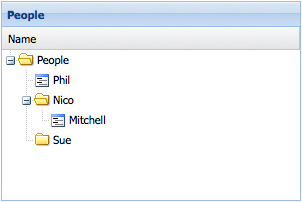
Important items to note:需要注意的要点:
- For all non-leaf nodes that do not have children (for example, Person with name Sue above), the server response MUST set the
loadedproperty totrue. Otherwise the proxy will attempt to load children for these nodes when they are expanded.对于所有没有孩子的非叶子节点(例如,名为Sue的Person),服务器响应必须设置loaded属性为true。否则,当它们被展开的时候,proxy会视图去获取其子节点。 - The question then arises - if the server is allowed to set the
loadedproperty on a node in the JSON response can it set any of the other non-persistent fields? The answer is yes - sometimes. In the example above the node with name "Nico" has isexpandedfield set totrueso that it will be initially displayed as expanded in the Tree Panel. Caution should be exercised as there are cases where this is not appropriate and could cause serious problems, like setting therootproperty on a node that is not the root node for example. In generalloadedandexpandedare the only cases where it is recommended for the server to set a non-persistent field in the JSON response.问题来了--如果服务器被允许设置loaded属性,它可以设置其它非持久化字段吗?答案是 yes --有时候。上例中,"Nico "节点是被展开的节点,因此在tree panel中初始是展开的。需要注意的是,有些属性设置会引起严重的问题,例如对非root节点设置root属性。通常,loaded和expanded是仅有的两个推荐在服务器端设置的非持久化属性。
Dynamically Loading Children When a Node is Expanded 当节点展开时的动态加载
For larger trees it may be desirable to only load parts of the tree by loading child nodes only when their parent node is expanded. Suppose in the above example, that the node with name "Sue" does not have its loaded field set to true by the server response. The Tree would display an expander icon next to the node. When the node is expanded the proxy will make another request to the readPersons url that looks something like this:
对于较大的树,期望的做法是开始只加载部分节点,然后当父节点展开的时候,才加载孩子节点。假设在上面的例子中,“sue节点的loaded属性没有被服务器设置为true。树会在节点的旁边显示一个expander 图标。当节点被展开,proxy会发起另外一个请求到readPersons 链接,如:
/readPersons?node=4
This tells the server to retrieve the child nodes for the node with an id of 4. The data should be returned in the same format as the data that was used to load the root node:
这告诉服务器去获取id为4的节点的孩子节点。数据将以与加载根节点一样的格式返回:
{ "success": true, "children": [ { "id": 5, "name": "Evan", "leaf": true } ] }
Now the Tree looks something like this:
现在,树节点看起来是这样:
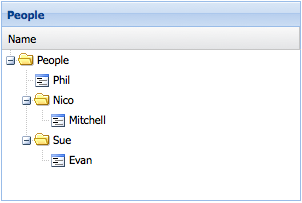
Saving Data 保存数据
Creating, updating, and deleting nodes is handled automatically and seamlessly by the Proxy.
创建、更新、删除节点会自动处理,并通过proxy无缝衔接。
Creating a New Node 创建新节点
// Create a new node and append it to the tree: var newPerson = Ext.create('Person', { name: 'Nige', leaf: true }); store.getNodeById(2).appendChild(newPerson);
Since the proxy is defined directly on the Model, the Model's save() method can be used to persist the data:
由于直接在model上定义了proxy,model的save()方法可以被用来持久化数据:
newPerson.save();
Updating an Existing Node 更新节点
store.getNodeById(1).set('name', 'Philip');
Removing a Node 移除节点
store.getRootNode().lastChild.remove();
Bulk Operations 批量操作
After creating, updating, and removing several nodes, they can all be persisted in one operation by calling the TreeStore's sync() method:
在创建、更新、删除几个节点后,它们可以调用TreeStore的sync()方法在一个操作中完成持久化。
store.sync();